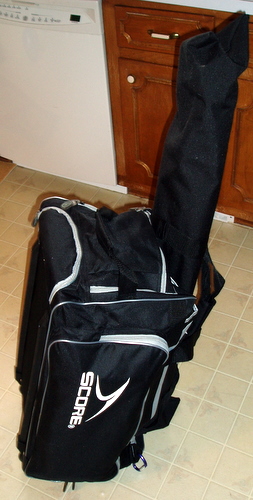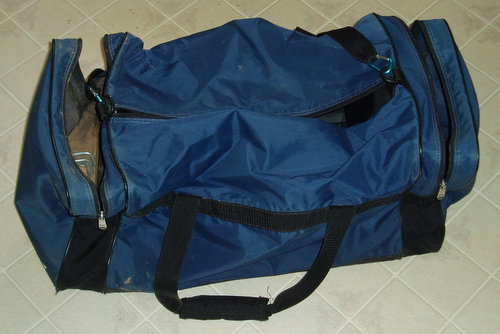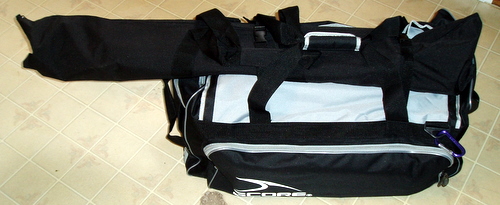One thing few new youth soccer coaches are prepared for is ‘the stuff’. It starts innocently enough, checking that "I’d like to volunteer" box on your child’s soccer registration. Then suddenly after a cryptic phone call with a ‘league officer’ where they seem to say "It’s great you want to help – welcome to the league" before you’re done saying "Hello?", you find yourself the proud new coach of a bunch of 4 year olds. At your first coaches meeting, you start to accumulate … stuff. Whistle, stopwatch, a first aid kit, maybe a few cones, and a shiny new soccer ball. Easy enough, you figure. Tell the kids to bring their own ball, a water bottle, and you can carry this new gear in a small backpack.
At the first practice, little Jenny forgets her ball and needs one to play. So you head to the local sporting goods shop where the owner, with what seems like a look of knowing pity, sells you 6 new soccer balls. As you get ready to pay, she asks ‘Would you like a ball bag to carry them?’ With that – your stuff has a new home. As the season goes on and it gets warmer, you suddenly find kids forgetting water bottles and having to run to the water fountain too often. So you pickup a small water cooler and some paper cups. You’ve got two hands, so water cooler in one hand and ball bag in the other with your coaches gear stuffed in. Then you have to practice in the rain. The balls are in your ball bag covered in grass clippings and mud, so you don’t want to put the other gear in with them to get home. The lady at the sporting goods store recognizes you and has a nice sports bag on the counter before you can ask for one. It has a shoulder strap, so you still have two hands to carry the ball bag and water cooler. How did she know that’s what you had come in for?
When you get the bag home, it seems really big for the few things you put into it, but it keeps things from getting filthy. It even has a nice side pocket for your cleats. A few months later you throw in some pinnies for scrimmages and a ball pump because the balls always seem to be flat when you need them. Along the way as you moved up with your child, the league threw in a nice dry erase clipboard. A year later you notice that one team has kids with agile feet and the coach has this thing called an agility ladder that the kids love to run through. $30 later and you notice your bag is heavier than ever. You wonder how you managed to acquire 30 cones along the way. And where did you end up with two bright colored keepers jerseys?
Then it happens. You’ve worked your way up to coaching U10 and the straps finally break off your gear bag because of how heavy it is.
A while back I wrote how youth soccer coaches were pack mules with all the stuff they usually carried to practice. Some coaches take a minimalist approach to practice, telling the kids to bring most stuff. But eventually most will bring a minimum of a ball of bags and a first aid kit. I happen to be one of those coaches who was also a boy scout and believes in being prepared. Which is just a polite way of saying I’m a pack rat and have all sorts of stuff in my gear bag. After coaching for five years now and accumulating all sorts of stuff, my old gear bag finally gave out. The plastic hooks on the shoulder strap had broken a couple years ago and had been replaced with cheap aluminum carabiners. Finally the bag tore where the strap attached and I had to carry it by the handle. Except I didn’t have a free hand considering I usually was carrying the water cooler, holding at least one toddler’s hand, and dragging a bag of balls on my shoulder.
So it was time for a new gear bag. While looking around, I found an inexpensive one with wheels and was sold.
It’s a couple inches larger than my original bag, but the best part is it has wheels. Since my ball bag has shoulder straps, I can easily drag the gear around on wheels. They even have metal shafts and bearings so they should last a while. There is also a thick plastic assembly around the wheels so the material doesn’t wear on the ground if the bag tilts. The handle retracts into the bag and is covered by a zippered flap to protect it (and hide it from the kids who will yank it out and shove it back in nonstop). Instead of a slit across the top, the entire top of the bag is a large flap – making it easier to find stuff. Plus there is a ridge flap over the zipper on top and an inner liner to prevent water from getting in if it’s out in the rain. Two soccer balls fit into a separate collapsible compartment on the side, keeping the inside of your bag a bit cleaner. Just a bit.

Now, you may be wondering what the long black bag is on top. With the money I saved on the bag, I bought a set of 6 coaching stix for fun. Many of my players have run agility courses with the stix and love them. The gear bag has straps across the top with quick snap buckles. So I can strap the stix onto the bag when I need to bring them to practices. Since I don’t use the shoulder strap, I put a large carabiner in the top strap eyelet. When the water cooler is empty after practice or a match, I just snap the handle into the carabiner to free up one more hand on the way back to the car!
So there you have it. The pack mule has a cart now. Our first weekend of matches was this past weekend and it was hectic (being a league officer AND a coach on game days is always fun), so it was great to be able to drag my bag along behind me as I had to go from one field to the complex building to another field and back again. If the bag lasts a couple of years, it’ll have been well worth what I paid for it. Considering my trusty old bag (below) was purchased about 4 years ago and got hauled all over the place, it served it’s purpose.

So if you find yourself hauling team gear to fields that seem to get farther and farther from the parking lot each year – maybe it’s time to think about getting a cart 🙂 I know, I know. I could haul around less stuff, but I’ve rarely found something in my bag that didn’t get used during the season. So I’ve resigned myself to hauling stuff from minivan to field on a regular basis. Now that chore just got easier.






Leave a Reply